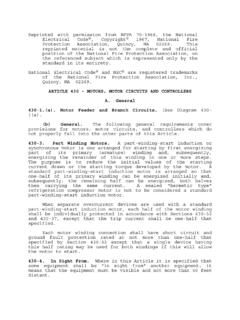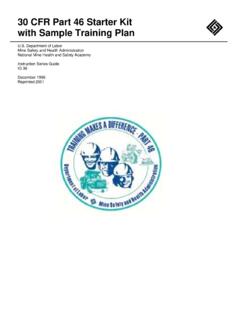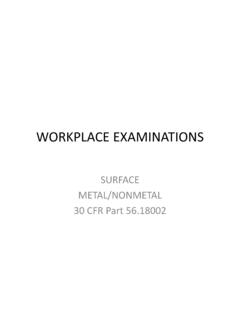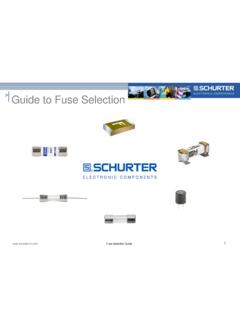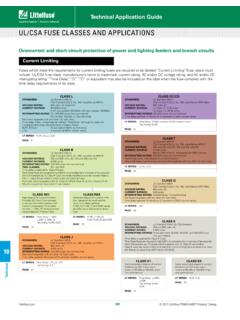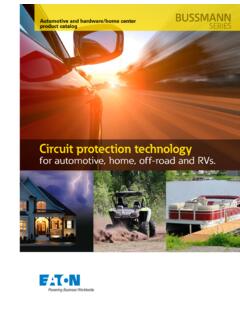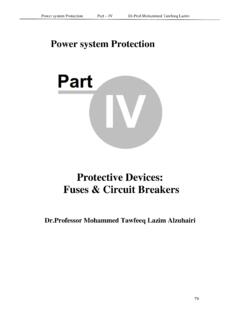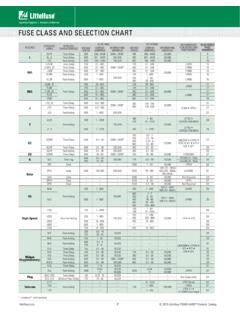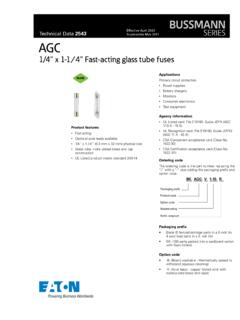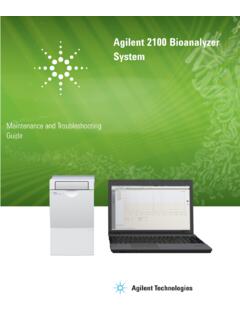Transcription of ARTICLE 240 - OVERCURRENT PROTECTION A. Installation
1 Reprinted with permission from NFPA 70-1968, the National Electrical Code , Copyright 1967, National Fire PROTECTION Association, Quincy, MA 02269. This reprinted material is not the complete and official position of the National Fire PROTECTION Association, on the referenced subject which is represented only by the standard in its entirety. National Electrical Code and NEC are registered trademarks of the National Fire PROTECTION Association, Inc., Quincy, MA 02269. ARTICLE 240 - OVERCURRENT PROTECTION A. Installation Scope. This ARTICLE provides the general requirements for the application of OVERCURRENT protective devices. 240-2. Purpose of OVERCURRENT PROTECTION . OVERCURRENT PROTECTION for conductors and equipment is provided for the purpose of opening the electric circuit if the current reaches a value which will cause an excessive or dangerous temperature in the conductor or conductor insulation.
2 240-3. PROTECTION of Equipment. Equipment shall be protected against OVERCURRENT as specified in the references in the following list: Equipment ARTICLE No. Appliances .. 422 Capacitors .. 460 Cranes and Hoists .. 610 Elevators, Dumbwaiters and Escalators .. 620 Emergency Systems .. 700 Fixed Electric Space Heating Equipment .. 424 Generators .. 445 Inductive and Dielectric Heat Generating Equipment .. 665 Machine Tools .. 670 Motion Picture Studios and Similar Locations .. 530 Motors .. 430 Organs .. 650 Over 600 Volts .. 710 Remote-Control Low-Energy Power, Low-Voltage Power and Signal Circuits .. 725 Services .. 230 Signs and Outline Lighting .. 600 Sound Equipment .. 640 Switchboards and Panelboards .. 384 Theaters and Assembly Halls .. 520 Transformers .. 450 Welders.
3 630 X-ray Equipment .. 660 240-4. Time-Delay OVERCURRENT Devices. Circuit breakers and plug fuses installed in residential occupancies on circuits of 20 amperes or less shall be of the time-delay type. 240-5. OVERCURRENT PROTECTION . (a) Conductors. Conductors shall be protected in accordance with their ampacities, as given in Tables 310-12 through 310-15, except as follows: Exception No. 1. Rating of Nonadjustable OVERCURRENT PROTECTION of 800 Amperes or Less. Where the standard ampere ratings of fuses and nonadjustable circuit breakers do not correspond with the allowable ampacities of conductors, the next higher standard rating may be used, only where the rating is 800 amperes or less. Exception No. 2. Adjustable-Trip Circuit Breakers. Adjustable-trip circuit breakers of the thermal trip, magnetic time-delay trip or instantaneous-trip types shall be set to operate at not more than 125 per cent of the allowable ampacity of the conductors.
4 The effect of the temperature on the operating of thermally controlled circuit breakers should be taken into consideration in the application of such circuit breakers when they are subjected to extremely low or extremely high temperatures. Exception No. 3. Fixture Wires and Cords. Fixture wire or flexible cord, Size No. 16 or No. 18, and tinsel cord shall be considered as protected by 20 ampere OVERCURRENT devices except as provided in Section 620-61. Fixture wires of the sizes permitted for taps in Section 210-19 (c-2) shall be considered as protected by the OVERCURRENT device of the branch circuit of ARTICLE 210 when conforming to the following: 20 ampere circuits, No. 18 cord and larger. 30 ampere circuits, cord of 10 amperes capacity and over. 40 ampere circuits, cord of 20 amperes capacity and over. 50 ampere circuits, cord of 20 amperes capacity and over. Exception No.
5 4. Motor Circuits. The conductors supplying motors and motor-operated appliances shall be considered as protected by the OVERCURRENT protective devices specified in Sections 530-32, 430-34, 430-52, 430-53, 430-62. Exception No. 5. Remote Control. Except as provided in ARTICLE 725, the conductors of the control circuits of remote-control switches shall be considered as protected from OVERCURRENT by OVERCURRENT devices that are not of the so-called time-lag type and are rated or set at not more than 500 per cent of the ampacity of the remote-control conductors, as specified in Tables 310-12 through 310-15. (b) Standard Ratings. Standard ampere ratings for fuses and nonadjustable circuit breakers are 15, 20, 25, 30, 35, 40, 45, 50, 60, 70, 80, 90, 100, 110, 125, 150, 175, 200, 225, 250, 300, 350, 400, 450, 500, 600, 700, 800, 1000, 1200, 1600, 2000, 2500, 3000, 4000, 5000, and 6000.
6 240-6. Fuses. (a) Plug fuses and fuseholders shall not be used in circuits exceeding 125 volts between conductors except in circuits supplied from a system having a grounded neutral and no conductor in such circuits operating at more than 150 volts to ground. (b) cartridge fuses and fuseholders rated at 300 volts shall not be used in circuits exceeding 300 volts between conductors except in circuits supplied from a system having a grounded neutral and no conductor in such circuits operating at more than 300 volts to ground. (c) The screw-shell of plug-type fuseholders shall be connected to the load side of the circuit. 240-8. Thermal Devices. Thermal cutouts, thermal relays and other devices not designed to open short-circuits, shall not be used for PROTECTION of conductors against OVERCURRENT due to short-circuits or grounds but may be used to protect motor branch circuit conductors from overload if protected in accordance with Section 430-40.
7 240-9. Feeders at Supply Stations. Each conductor of a constant-potential circuit entering or leaving a supply station, except grounded neutral conductors, shall be protected from excessive current by a circuit breaker, or by an equivalent device of approved design. Such protective devices shall be located as near as practicable to the point where the conductors enter or leave the building. For the outgoing circuits not connected with other sources of power, the protective devices may be placed on the supply side of transformers or similar devices. 240-11. Ungrounded Conductors. (a) An OVERCURRENT device ( fuse or OVERCURRENT trip unit of a circuit breaker) shall be placed in each ungrounded conductor. For motor circuits see ARTICLE 430. (b) Circuit breakers shall open all ungrounded conductors of the circuit, except as follows: Exception: Individual single-pole circuit breakers may be used for the PROTECTION of each conductor of ungrounded 2-wire circuits, each ungrounded conductor of 3-wire direct-current or single-phase circuits, or for each ungrounded conductor of lighting or appliance branch circuits connected to 4-wire three-phase systems or 5-wire 2-phase systems, provided such lighting or appliance circuits are supplied from a system having a grounded neutral and no conductor in such circuits operates at a voltage greater than permitted in Section 210-6.
8 240-12. Grounded Conductor. No OVERCURRENT device shall be placed in any permanently grounded conductor, except as follows: Exception No. 1. Where the OVERCURRENT device simultaneously opens all conductors of the circuit. Exception No. 2. For motor-running PROTECTION as provided in Sections 430-36 and 430-37. 240-13. Change in Size of Grounded Conductor. Where a change occurs in the size of the ungrounded conductor, a similar change may be made in the size of the grounded conductor. 240-14. Fuses or Circuit Breakers in Parallel. OVERCURRENT devices consisting of fuses and/or circuit breakers shall not be arranged or installed in parallel. Exception: Circuit breakers assembled in parallel which are tested and approved as a single unit. B. Location 240-15. Location in Circuit. OVERCURRENT devices shall be located at the point where the conductor to be protected receives its supply, except as follows: Exception No.
9 1. Service Conductors. An OVERCURRENT protective device for service conductors may be located as specified in Section 230-91. Exception No. 2. Smaller Conductor Protected. Where the OVERCURRENT device protecting the larger conductors also protects the smaller conductors in accordance with Tables 310-12 through 310-15. Exception No. 3. Branch Circuits. Taps to individual outlets and circuit conductors supplying a single household electric range shall be considered as protected by the branch circuit OVERCURRENT devices when in accordance with the requirements of Sections 210-19, 210-20 and 210-25. Exception No. 4. Feeder Taps. A conductor tapped from a feeder shall be considered as properly protected from OVERCURRENT when installed in accordance with Sections 364-8 and 430-59. Exception No. 5. Feeder Taps Not Over 10 Feet Long.
10 Where (1) the smaller conductor has an ampacity of not less than the sum of the allowable ampacities for the conductors of the one or more circuits or loads supplied, and (2) the tap is not over 10 feet long and does not extend beyond the switchboard, panelboard, or control devices which it supplied, and (3) except at the point of connection to the feeder, the tap is enclosed in conduit, electrical metallic tubing, or in metal gutters when not a part of the switchboard or panelboard. Exception No. 6. Feeder Taps Not Over 25 Feet Long. Where the smaller conductor has an ampacity at least one-third that of the conductor from which it is supplied, and provided the tap is suitably protected from physical damage, is not over 25 feet long, and terminates in a single circuit breaker or set of fuses which will limit the load on the tap to that allowed by Tables 310-12 through 310-15.





